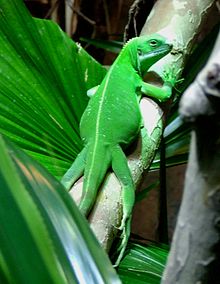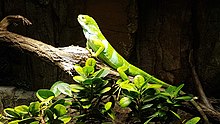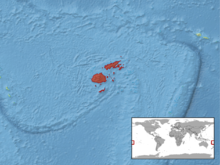Brachylophus bulabula
| Brachylophus bulabula | |
|---|---|

| |
| Female, Cologne Zoological Garden | |

| |
| Male | |
| Scientific classification | |
| Kingdom: | Animalia |
| Phylum: | Chordata |
| Class: | Reptilia |
| Order: | Squamata |
| Suborder: | Iguania |
| Family: | Iguanidae |
| Genus: | Brachylophus |
| Species: | B. bulabula
|
| Binomial name | |
| Brachylophus bulabula Keogh, Edwards, Fisher, & Harlow, 2008
| |

| |
Brachylophus bulabula (central Fijian banded iguana) is a species of iguanid lizard endemic to some of the larger central and northwestern islands of Fiji (Ovalau, Kadavu and Viti Levu), where it occurs in Fijian wet forest. It was described by a team led by a scientist from the Australian National University in 2008.[2][3] It is one of the few species of iguana found outside of the New World and one of the most geographically isolated members of the family Iguanidae.[4] Initially also reported from Gau Island, in 2017 this population was described as a separate species, B. gau.[5]
Taxonomy and etymology[]
The generic name, Brachylophus, is derived from two Greek words: brachys (βραχυς) meaning "short" and lophos (λοφος) meaning "crest" or "plume", denoting the short spiny crests along the back of this species. The specific name, bulabula, is a doubling of the Fijian word for "hello": bula.
The species is closely related to the Fiji banded iguana and the Fiji crested iguana. This species was described after a mitochondrial DNA analysis of 61 iguanas from 13 islands showed that B. bulabula was genetically and physically different from the two other species.
All species in this genus are thought to have evolved from ancestors that rafted 9,000 km (5,600 mi) west across the Pacific Ocean from the Americas, where their closest relatives are found.[6][7] It has also been suggested that the genus evolved from iguanas that crossed, in part over dry land bridges, to Fiji from Southeast Asia.[8]
Diet[]
Fiji iguanas are herbivorous; they feed on the leaves, fruit, and flowers of trees and shrubs, particularly hibiscus flowers of the Vau tree (Hibiscus tiliaceus) and fruit such as banana and papaya.[9][page needed] Hatchlings may feed on insects; however, adults usually will not.[9][page needed]
References[]
- ^ Fisher, R.; Grant, T.; Harlow, P. (2012). "Brachylophus bulabula". IUCN Red List of Threatened Species. 2012: e.T174471A1414101. doi:10.2305/IUCN.UK.2012.RLTS.T174471A1414101.en. Retrieved 17 December 2019.
- ^ Cooper, Dani (2008-09-16). "Hello, it's a new species of Pacific iguana". ABC Science. Australian Broadcasting Corporation. Retrieved 2010-09-28.
- ^ Keogh, J. Scott; Edwards, Danielle L.; Fisher, Robert N.; Harlow, Peter S. (2008-10-27). "Molecular and morphological analysis of the critically endangered Fijian iguanas reveals cryptic diversity and a complex biogeographic history". Philosophical Transactions of the Royal Society B. 363 (1508): 3413–3426. doi:10.1098/rstb.2008.0120. PMC 2607380. PMID 18782726.
- ^ Kinkaid, John (1997). "Iguanas of the South Pacific". Reptiles. 5 (8): 54–57.
- ^ Fisher, Robert N.; Jone Niukula; Dick Watling; Peter S. Harlow (2017). "A New Species of Iguana Brachylophus Cuvier 1829 (Sauria: Iguania: Iguanidae) from Gau Island, Fiji Islands". Zootaxa. 4273 (3): 407–422. doi:10.11646/zootaxa.4273.3.5. PMID 28610241.
- ^ Cogger, Harold (1974). "Voyage of the Banded Iguana". Australia Natural History. 18 (4): 144–149.
- ^ Gibbons, J. R. H. (Jul 31, 1981). "The Biogeography of Brachylophus (Iguanidae) including the Description of a New Species, B. vitiensis, from Fiji". Journal of Herpetology. 15 (3): 255–273. doi:10.2307/1563429. JSTOR 1563429.
- ^ Noonan, B.P.; Sites, J.W. Jr. (2009). "Tracing the origins of iguanid lizards and boine snakes of the Pacific". The American Naturalist. 175 (1): 61–72. doi:10.1086/648607. PMID 19929634.
- ^ Jump up to: a b Sprackland, Robert George (1992). Giant lizards. T.F.H. Publications. ISBN 978-0-86622-634-9.
- IUCN Red List endangered species
- Brachylophus
- Reptiles of Fiji
- Reptiles described in 2008
- Taxa named by J. Scott Keogh
